Sharefarming is an umbrella term for various systems of farming in which sharefarmers make use of agricultural assets they do not own in return for a percentage share of the profits, whether this be in currency or in kind.
Sharecropping as historically practiced in the USA during the Reconstruction era (late 19th-century) is one of many implementations of sharefarming; another, known as métayage or mezzadria, was, and remains, practiced in southern France, in Italy, and in Canada. The meaning of the latter term shifted over the centuries from one in which farmers share in the crops they harvest to one in which they share in the profits from their sale. (The landlords of a so-called métairie were known as bailleurs or concedenti and the sharecroppers as prendeurs or mezzadri.)
Métayage of the older sort, re-christened as colonat partiaire, was practiced in Africa and in the overseas departments of France until modern times; its last vestiges vanished from Réunion in 2006. On the other hand, métayage as it is defined today remains one of the options for running a farm and is given a legal backbone in the Code rural, livre IV, as well as in several laws of the European Union. [1] [2] [3]
Occasionally, the term sharefarmer is used to denote a farmer who receives a wage (fixed per hour, week, month, or area) from the landlord, although such a person is normally considered a tenant farmer or farm labourer. Two common implementations of the sharefarming concept are sharecropping and sharemilking, although it has been applied to other sorts of agricultural assets.
Sharefarming was common[ when? ] in colonial Africa, in Scotland, and in Ireland; it came into wide use in the United States during its post-bellum Reconstruction Era. In Europe, especially France and Italy, a sharefarming system called metayage once commonly occurred.
While sharefarming as practiced in many poor parts of the world can be seen as a form of oppression similar to feudal serfdom, it is not inherently exploitative. Métayage, under its modern-day meaning, remains common in Canada, and in fact compares very favourably to other farming arrangements on the basis of taxation. Sharefarming in the broad sense finds good use where individual farmers prefer not to have complete responsibility for agricultural assets such as the land or livestock, and in such applications it is not considered exploitative.
Sharecropping is the most common application of the sharefarming principle. In practice, sharefarmers work land which they don't own in return for varying portions of the total profit. In many cases where it is practiced in very poor farming communities it is considered an exploitative model. Sharecropping began after the Civil War and ended between the 1930s and the 1940s because when machines came that could to farming more easily, landowners didn't need actual people working the fields.
Sharemilking is the application of the sharefarming concept to the dairy industry; it is particularly common in New Zealand but is not unheard of elsewhere. The specific arrangement to which the term sharemilking is understood (via synecdoche) to apply is less ambiguously known as herd-owning or fifty-fifty sharemilking.
Under 50:50 sharemilking, graziers (prendeurs) own their cattle and equipment outright, employ their own labourers, and preside over day-to-day operations at the grazing end of the arrangement (or their part thereof). Milking operations, meanwhile, are undertaken by shared sheds that loan out their labourers, equipment, and time in return for a 50% fee for services rendered. Land can be owned by the milking shed or by a bailleur, a third-party career landlord (both are types of rentier), but in a subversion of the typical rentier model, the grazier himself may own the land on which his cattle graze. This is ubiquitous on semi-sedentary métairies, where the economic model de facto straddles the line between rentier capitalism and commission sales.
Naïvely, milking sheds may be conceptualised as taking fifty per cent. profit in exchange for contributing fifty per cent. of capital and assuming fifty per cent. of risk. While this picture is complicated by the ubiquity of multilateral sharemilking arrangements, wherein a milking shed is shared by multiple prendeurs and extracts its usual and customary fee from each, the "50:50" moniker remains generally accurate from the milking shed's perspective.
This arrangement benefits both rentiers and prendeurs. In-house milking facilities tend to lie empty and unused for a good chunk of the day that could otherwise be spent doing productive (and thus profitable) work. Likewise, land that lies empty and ungrazed serves no purpose, but can be turned to profit landowners who own neither cattle nor milking shed.
Graziers participating in a sharemilking scheme have the opportunity to save money and bring their milking facility in-house if they so desire. Sharemilking can also aid graziers who aspire to own land but at present do not in acquiring it; those who have no desire to own land can instead acquire more cattle. [4]
Variable order sharemilking, under which prendeurs do not own their own herd, and receive a lower percentage of the milk income, is identical to the French métairie but applied to dairy operations in New Zealand. Contract milking is similar to variable order sharemilking, the difference being that milkers are paid a fixed price per kilogram of milk solids rather than a proportion; this is enough to exclude it from métairie altogether. [5]
Sharemilking contracts typically run from 1 June to 31 May; when sharemilkers take up new contracts, the herd is often shifted on what is known as "Gypsy Day". [6]
The model is not exploitative, and over time, sharemilkers often slowly buy out the landholder, or alternatively use the system as a method to save for their own property. This practice helps dairy farmers anywhere who do not wish the burdens of owning their own land, as it allows them to focus their investment in livestock and equipment. Sharemilking also profits former dairy farmers who have given up their herds, by providing them with an income from rental of fields, pastures and barns.
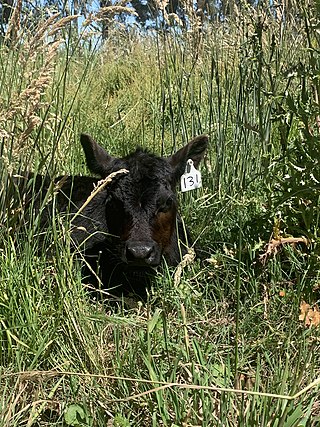
A calf is a young domestic cow or bull. Calves are reared to become adult cattle or are slaughtered for their meat, called veal, and hide.
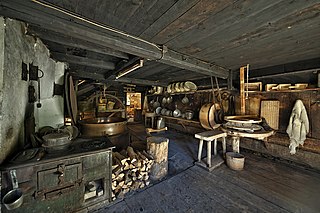
A dairy is a place where milk is stored and where butter, cheese and other dairy products are made, or a place where those products are sold. It may be a room, a building or a larger establishment. In the United States, the word may also describe a dairy farm or the part of a mixed farm dedicated to milk for human consumption, whether from cows, buffaloes, goats, sheep, horses or camels.

A farmer is a person engaged in agriculture, raising living organisms for food or raw materials. The term usually applies to people who do some combination of raising field crops, orchards, vineyards, poultry, or other livestock. A farmer might own the farm land or might work as a laborer on land owned by others. In most developed economies, a "farmer" is usually a farm owner (landowner), while employees of the farm are known as farm workers. However, in other older definitions a farmer was a person who promotes or improves the growth of plants, land or crops or raises animals by labor and attention.
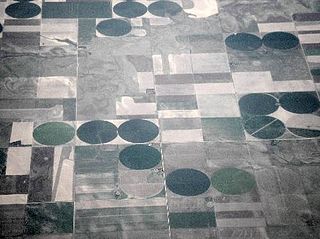
A farm is an area of land that is devoted primarily to agricultural processes with the primary objective of producing food and other crops; it is the basic facility in food production. The name is used for specialized units such as arable farms, vegetable farms, fruit farms, dairy, pig, and poultry farms, and land used for the production of natural fiber, biofuel, and other commodities. It includes ranches, feedlots, orchards, plantations and estates, smallholdings, and hobby farms, and includes the farmhouse and agricultural buildings as well as the land. In modern times, the term has been extended so as to include such industrial operations as wind farms and fish farms, both of which can operate on land or at sea.

The Holstein Friesian is an international breed or group of breeds of dairy cattle. It originated in the Dutch provinces of North Holland and Friesland and in Schleswig-Holstein in northern Germany. It is the dominant breed in industrial dairy farming worldwide, and is found in more than 160 countries. It is known by many names, among them Holstein, Friesian and Black and White.

Sharecropping is a legal arrangement with regard to agricultural land in which a landowner allows a tenant to use the land in return for a share of the crops produced on that land.
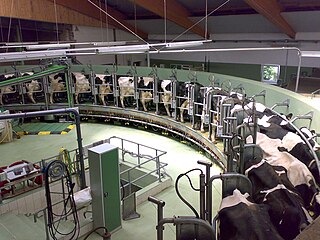
Dairy farming is a class of agriculture for long-term production of milk, which is processed for eventual sale of a dairy product. Dairy farming has a history that goes back to the early Neolithic era, around the seventh millennium BC, in many regions of Europe and Africa. Before the 20th century, milking was done by hand on small farms. Beginning in the early 20th century, milking was done in large scale dairy farms with innovations including rotary parlors, the milking pipeline, and automatic milking systems that were commercially developed in the early 1990s.

Dairy cattle are cattle bred for the ability to produce large quantities of milk, from which dairy products are made. Dairy cattle generally are of the species Bos taurus.
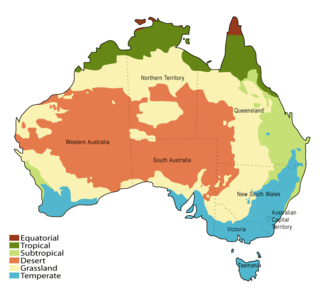
Although Australia is mostly arid, the nation is a major agricultural producer and exporter, with over 325,300 employed in agriculture, forestry and fishing as of February 2015. Agriculture and its closely related sectors earn $155 billion-a-year for a 12% share of GDP. Farmers and grazers own 135,997 farms, covering 61% of Australia's landmass. Across the country there is a mix of irrigation and dry-land farming. The success of Australia to become a major agricultural power despite the odds is facilitated by its policies of long-term visions and promotion of agricultural reforms that greatly increased the country's agricultural industry.

The metayage system is the cultivation of land for a proprietor by one who receives a proportion of the produce, as a kind of sharecropping. Another class of land tenancy in France is named fermage, whereby the rent is paid annually in banknotes. A farm operating under métayage was known as a métairie, the origin of some place names in areas where the system was used, such as Metairie, Louisiana.
Sharemilking, a form of sharefarming, operates in the dairy industry. The application of this model of agriculture occurs particularly commonly in New Zealand.

Pastoral farming is aimed at producing livestock, rather than growing crops. Examples include dairy farming, raising beef cattle, and raising sheep for wool. In contrast, arable farming concentrates on crops rather than livestock. Finally, mixed farming incorporates livestock and crops on a single farm. Some mixed farmers grow crops purely as fodder for their livestock; some crop farmers grow fodder and sell it. In some cases pastoral farmers are known as graziers, and in some cases pastoralists. Pastoral farming is a non-nomadic form of pastoralism in which the livestock farmer has some form of ownership of the land used, giving the farmer more economic incentive to improve the land. Unlike other pastoral systems, pastoral farmers are sedentary and do not change locations in search of fresh resources. Rather, pastoral farmers adjust their pastures to fit the needs of their animals. Improvements include drainage, stock tanks, irrigation and sowing clover.
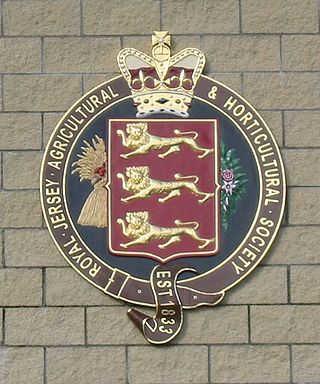
The Royal Jersey Agricultural & Horticultural Society (RJA&HS) is an agricultural association in Jersey. It has been instrumental in the development of the Jersey cow and its success throughout the world, and today is responsible for management of the breed in its Island home.

In New Zealand, agriculture is the largest sector of the tradable economy. The country exported NZ$46.4 billion worth of agricultural products in the 12 months to June 2019, 79.6% of the country's total exported goods. The agriculture, forestry and fisheries sector directly contributed $12.653 billion of the national GDP in the 12 months to September 2020, and employed 143,000 people, 5.9% of New Zealand's workforce, as of the 2018 census.
In Sri Lanka many farmers depend on animal husbandry for their livelihood, but not a large proportion. Therefore, many livestock products have to be imported. The main livestock products in Sri Lanka are milk, meat and eggs. Hides, wools and other products are still not produced within the country. Animal power formerly used in the cultivation of rice and vegetables have been replaced by modern technology to farmlands. However animal husbandry plays an important role in the rural economy for improving the living conditions of farmers in the country.

Dairy farming in New Zealand began during the early days of colonisation by Europeans. The New Zealand dairy industry is based almost exclusively on cattle, with a population of 4.92 million milking cows in the 2019-20 season. The income from dairy farming is now a major part of the New Zealand economy, becoming an NZ$13.4 billion industry by 2017.
Agriculture has historically been the primary industry of the English county of Cheshire. Dairy farming has predominated, and the county was particularly known for cheese-making.

A cowman is a person who works specifically with cattle.
A herdshare is a contractual arrangement between a farmer and an owner of livestock - the shareholder or member - through which the shareholder is able to obtain raw milk, meat, offal and other profits of the livestock proportionate to the shareholder's interest in the herd. Herdshares include cowshares, goatshares, and sheepshares, and are sometime referred to as "farmshares" or "dairy-shares," although the term "farmshare" can also refer to an entire farm held in joint ownership.

Agriculture in Wales has in the past been a major part of the economy of Wales, a largely rural country that forms part of the United Kingdom. Wales is mountainous and has a mild, wet climate. This results in only a small proportion of the land area being suitable for arable cropping, but grass for the grazing of livestock is present in abundance. As a proportion of the national economy, the importance of agriculture has become much reduced; a high proportion of the population now live in the towns and cities in the south of the country and tourism has become an important form of income in the countryside and on the coast. Arable cropping is limited to the flatter parts and elsewhere dairying and livestock farming predominate.
Thousands of farm animals and hundreds of households will be on the move in Gypsy day, as farms change hands and sharemilkers take up new contracts from Saturday, 31 May.
{{cite news}}: CS1 maint: others (link)